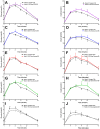Effects of Consuming Beverages Sweetened with Fructose, Glucose, High-Fructose Corn Syrup, Sucrose, or Aspartame on OGTT-Derived Indices of Insulin Sensitivity in Young Adults
- PMID: 38201980
- PMCID: PMC10780640
- DOI: 10.3390/nu16010151
Effects of Consuming Beverages Sweetened with Fructose, Glucose, High-Fructose Corn Syrup, Sucrose, or Aspartame on OGTT-Derived Indices of Insulin Sensitivity in Young Adults
Abstract
(1) Background: Clinical results on the effects of excess sugar consumption on insulin sensitivity are conflicting, possibly due to differences in sugar type and the insulin sensitivity index (ISI) assessed. Therefore, we compared the effects of consuming four different sugars on insulin sensitivity indices derived from oral glucose tolerance tests (OGTT). (2) Methods: Young adults consumed fructose-, glucose-, high-fructose corn syrup (HFCS)-, sucrose-, or aspartame-sweetened beverages (SB) for 2 weeks. Participants underwent OGTT before and at the end of the intervention. Fasting glucose and insulin, Homeostatic Model Assessment-Insulin Resistance (HOMA-IR), glucose and insulin area under the curve, Surrogate Hepatic Insulin Resistance Index, Matsuda ISI, Predicted M ISI, and Stumvoll Index were assessed. Outcomes were analyzed to determine: (1) effects of the five SB; (2) effects of the proportions of fructose and glucose in all SB. (3) Results: Fructose-SB and the fructose component in mixed sugars negatively affected outcomes that assess hepatic insulin sensitivity, while glucose did not. The effects of glucose-SB and the glucose component in mixed sugar on muscle insulin sensitivity were more negative than those of fructose. (4) Conclusion: the effects of consuming sugar-SB on insulin sensitivity varied depending on type of sugar and ISI index because outcomes assessing hepatic insulin sensitivity were negatively affected by fructose, and outcomes assessing muscle insulin sensitivity were more negatively affected by glucose.
Keywords: aspartame; dietary intervention study; fructose; glucose; hepatic insulin sensitivity; high-fructose corn syrup; insulin resistance; insulin sensitivity index; muscle insulin sensitivity; sucrose.
Conflict of interest statement
V.M. serves in the Advisory board of Alexion Pharmaceuticals. All other authors have no conflicts of interest to declare.
Figures





Similar articles
-
Consuming Sucrose- or HFCS-sweetened Beverages Increases Hepatic Lipid and Decreases Insulin Sensitivity in Adults.J Clin Endocrinol Metab. 2021 Oct 21;106(11):3248-3264. doi: 10.1210/clinem/dgab508. J Clin Endocrinol Metab. 2021. PMID: 34265055 Free PMC article.
-
The Dose-Response Effects of Consuming High Fructose Corn Syrup-Sweetened Beverages on Hepatic Lipid Content and Insulin Sensitivity in Young Adults.Nutrients. 2022 Apr 15;14(8):1648. doi: 10.3390/nu14081648. Nutrients. 2022. PMID: 35458210 Free PMC article.
-
Effects of Consuming Sugar-Sweetened Beverages for 2 Weeks on 24-h Circulating Leptin Profiles, Ad Libitum Food Intake and Body Weight in Young Adults.Nutrients. 2020 Dec 19;12(12):3893. doi: 10.3390/nu12123893. Nutrients. 2020. PMID: 33352724 Free PMC article. Clinical Trial.
-
Sugar consumption, metabolic disease and obesity: The state of the controversy.Crit Rev Clin Lab Sci. 2016;53(1):52-67. doi: 10.3109/10408363.2015.1084990. Epub 2015 Sep 17. Crit Rev Clin Lab Sci. 2016. PMID: 26376619 Free PMC article. Review.
-
Endocrine and metabolic effects of consuming beverages sweetened with fructose, glucose, sucrose, or high-fructose corn syrup.Am J Clin Nutr. 2008 Dec;88(6):1733S-1737S. doi: 10.3945/ajcn.2008.25825D. Am J Clin Nutr. 2008. PMID: 19064538 Free PMC article. Review.
Cited by
-
Targeting ultra-processed foods for prevention of type 2 diabetes: state of the evidence and future directions.Diabetologia. 2025 Mar;68(3):495-506. doi: 10.1007/s00125-025-06358-x. Epub 2025 Jan 18. Diabetologia. 2025. PMID: 39825911 Review.
-
The Effects of Aspartame on Glucose, Insulin, and Appetite-Regulating Hormone Responses in Humans: Systematic Review and Meta-Analyses.Adv Nutr. 2025 Jul;16(7):100449. doi: 10.1016/j.advnut.2025.100449. Epub 2025 May 15. Adv Nutr. 2025. PMID: 40381807 Free PMC article. Review.
-
Addressing Post-Acute COVID-19 Syndrome in Cancer Patients, from Visceral Obesity and Myosteatosis to Systemic Inflammation: Implications in Cardio-Onco-Metabolism.Biomedicines. 2024 Jul 24;12(8):1650. doi: 10.3390/biomedicines12081650. Biomedicines. 2024. PMID: 39200115 Free PMC article. Review.
References
-
- International Diabetes Federation IDF Diabetes Atlas, 10th ed. [(accessed on 15 November 2021)]. Available online: http://www.diabetesatlas.org.

